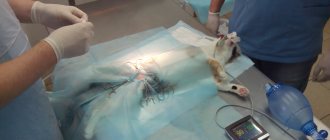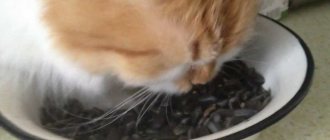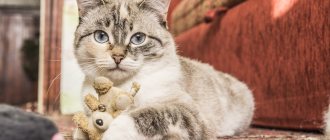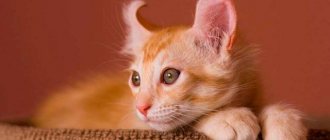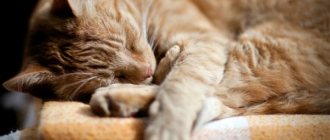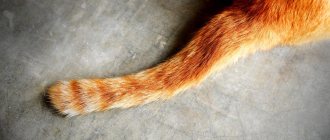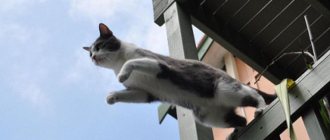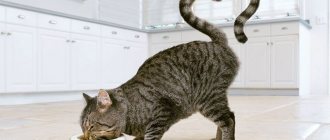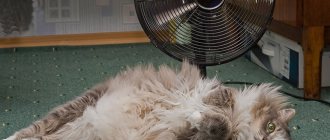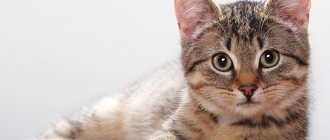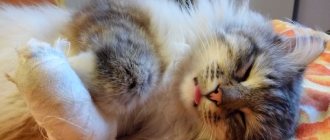Don and Canadian Sphynx
Some will find these breeds unattractive, while others will become their ardent admirers. Hairless cats are very loyal and affectionate pets who become very attached to their owners and suffer from loneliness. These breeds are an excellent choice for those who are not afraid of exotic appearance, but are attracted by the lack of hair and allergies. Sphynxes often get along easily with other pets, are good-natured towards children, and are not an aggressive and sociable breed.
The most popular cat breed No. 10. Don and Canadian Sphynxes
British behavior
A British breed cat does not like loud noises, and therefore tries to talk quietly and purr only when absolutely necessary. The British value their relaxation and privacy very much. They can easily sleep up to 20 hours a day.
The British cat is the personification of calm and true comfort in the home.
It is very important for a cat of this breed to know that she is loved. Some Britons even become jealous of their owner if he devotes a large amount of time to someone else. But a “tame” British cat is a rarity. The animal sits in the arms of the owner for a maximum of 5 minutes a day, and then, pretending to be a deep favor.
British cat care and maintenance >>
At the same time, other family members can only dream of holding him. Pure-blooded Britons sometimes even attack and bite strangers. It is possible to change such habits of an animal only in childhood, constantly exposing it to new people. This way the British cat will know that there are different smells and hands.
A feature of the behavior of British cats is “licking” and washing themselves after any psychological stress, for example, a serious “conversation” with the owner, a trip to an exhibition or a visit to the veterinarian. But it's not just stress that causes cleanliness for the British. Thanks to their innate aristocracy, these animals never shit in the wrong place, provided that their tray is clean. Only during puberty, like any member of the cat family, can Britons begin to mark their territory. Therefore, if you are not going to continue the offspring of your pet, it is better to castrate a British cat at the age of 8-10 months, and sterilize a cat.
Siamese cats
Blue-eyed short-haired beauties are liked by many breeders. Their characteristic feature is a flexible long body, a triangular muzzle and a peculiar color-point color with dark spots on the muzzle, ears, tail and paws. Contrary to popular belief, Siamese cats are not at all vicious, they are very attached to their owner, friendly, and adapted to society. Representatives of this breed are sociable and temperamental; their homeland is Siam, from which they were brought in the early 18th century. Now there are Siamese catteries in many European cities.
The most popular cat breed No. 9. Siamese cat
British (shorthair) cat
These cute teddy bears are now at the very peak of popularity - many people like this breed. The character of such pets is even, calm, and affectionate. They are unpretentious, easily adapt to new living conditions, and are suitable for families with children. These are heavy and large cats, distinguished by a soft and thick coat, round bright eyes and straight or hanging ears. The most popular colors are two-tone and tabby, but one-color pets are also very beautiful. This breed was developed in Great Britain in the 19th century by crossing domestic cats with Persian cats.
Most popular cat breed No. 8. British Shorthair
What to name a Scottish kitten
Many new owners of plush kittens prefer to follow the beaten path and give their pets well-known nicknames: Barsik, Murzik, Vaska. But for open-minded cat lovers, choosing a name for a boy or girl is a great way to show creativity and imagination.
What nickname can you come up with for your pet so that it is associated with Scotland? This is not difficult, because the history and culture of this country are known throughout the world. Kilt, bagpipes, whiskey, tartan - this is not a complete list of words that make us think of distant Scotland.
You can rack your brain and come up with a name based on the suggested words. But most often male kittens are named Scott (Scotty), Shot (Shotti), Valli, Rob, Roy, Baxter, Archie and even Holmes or Watson. The girls are called Foxy, Orange, Athena, Shakira, Martha, Chessie, Shaddy.
Scottish fold cat
The Scottish Fold cat with soft and dense hair of short or medium length has appealed to modern people. Scottish cats are very good-natured and have a confident and calm character. They are attached to their owners and love the company of people. They get along well with other animals and are partial to children. Kittens are born with straight ears; only after 4-5 weeks do their ears begin to lie down or remain straight. These cats were first documented in 1796; their homeland is Scotland.
The most popular cat breed No. 7. Scottish fold cat
Who is the best hunter - a cat or a cat?
Who is better at catching rodents - a male or a female? It is believed that the best rat hunters come from stray cats. Maternal instinct forces the female to hunt, and the cat hones her skills to perfection.
Males are not as active as cats. Their main task is procreation; for this, the cat needs to interest and attract the female. However, a cat deprived of food, forced to rely only on itself to solve the “food issue,” is guided by instinct and becomes an excellent hunter.
Cats hunt mice and rats most actively about once a quarter, before the approach of estrus. Consequently, about 3-4 times a year, a pet can clear a house or apartment of uninvited guests. The best candidate for the position of mouser is considered to be a cat.
Maine Coon
A beautiful and massive cat has won the hearts of many; this semi-long-haired breed is considered the largest in the world. A characteristic feature of the Maine Coon is lynx ears and a bushy tail, this is the embodiment of wild beauty and grace. Cats mature quite late - by the age of 5, their weight can reach 12-15 kilograms. Despite their powerful physique, the Maine Coon's character is quite flexible; they are sociable, affectionate and good-natured, amenable to training, and “talk” in a pleasant melodic voice. This beautiful raccoon cat is very hardy to weather conditions, and was bred more than 100 years ago in America, Maine, after which it was named.
The most popular cat breed No. 6. Maine Coon
Persian cat
An artificially bred long-haired breed, the characteristic features of which are a dense, even stocky figure, a wide head, a flat nose and a chic collar. These cats have a good-natured disposition, they are calm and intelligent. Their luxurious coat needs to be carefully combed every day. The breed was developed in Europe at the beginning of the 17th century, so it is considered very old. Since then, thanks to breeders, new varieties of colors and breeds have appeared.
The most popular cat breed No. 5. Persian cat
Exotic cat
This animal can be called a short-haired version of the Persian cat. This breed was developed only at the beginning of the 20th century in America. Exotics have funny faces with thick cheeks and a flattened nose, a short plush coat, this is a “Persian for the lazy”, for people who do not have enough time to brush their pet every day. These cats have a light and responsive character, they quickly get used to changes in the environment, they are playful and inquisitive. Such animals get along well with other representatives of the cat family and are friendly to children.
The most popular cat breed No. 4. Exotic cat
What are the “pros” and “cons” of castration/sterilization in cats?
Pros:
- calmer character, reduced aggression;
- elimination of most behavioral problems;
- lack of “tags”;
- reducing the risk of uterine cancer, disruption of the correct functioning of the mammary glands, ovaries;
- the cat does not rush outside, does not bother the owner with loud cries;
- the problem of “addition” of unplanned offspring does not arise.
Minuses:
- there is a minimal risk of complications (but under the supervision of an experienced veterinarian this probability is almost zero);
- the effect of anesthesia can be dangerous for elderly animals and those suffering from cardiovascular diseases (you must consult a veterinarian);
- with an incorrectly selected diet, the likelihood of obesity increases (if you do not limit your pet’s food intake);
You can avoid these disadvantages after surgery as follows:
- consult a veterinarian and conduct a preliminary examination of the animal;
- show maximum care and attention after medical intervention;
- provide the animal with specially selected food;
- do not overfeed the animal.
I would like to warn against using drugs to reduce sexual desire in animals instead of sterilization/castration. Very often, such drugs trigger extremely negative processes in the body, resulting in tumors and urolithiasis.
Please note that if a cat was indifferent to rodents before castration/sterilization, then after the operation they will not show interest in them. But if your pet proudly brought you his trophies, then even after medical intervention he will delight you with his achievements. Perhaps he will take a break of several days for complete recovery.
Was the article useful? Tell your friends what you read
According to veterinarians, a sterilized cat or neutered cat will not lose its hunting instincts, and therefore will continue to hunt rodents. Changes in character are possible, but there is no need to be afraid of drastic changes or increased laziness. To ensure that the medical procedure does not harm your pet, it is important to monitor the diet, follow the recommendations of veterinarians after surgery, and pay increased attention to the recovering animal.
Cornish Rex
A breed of short-haired cats, characterized by wavy whiskers and plush short hair. They are very energetic and muscular cats with a wedge-shaped head and large, bat-like ears. A Rex's tail is an indicator of mood; these cats can even wag their tail, become attached to people like dogs, are easy to train, and have enviable intelligence. These are sociable and sweet cats that get along well with children, but can dominate other animals. His coat does not require special care. The cat's homeland is considered to be Great Britain; they were bred in the 19th century and are considered the “intellectuals” in the cat world.
The most popular cat breed No. 3. Cornish Rex
Which cats are better at catching rats and mice?
Despite innovations, the most effective rodent exterminator remains the common cat. Initially, thanks to this quality, cats were able to win the love of humanity. Today, a cat is a friend and family member. However, the skills of a hunter and a ruthless exterminator of rodents are in demand to this day. Which cats catch rats masterfully, leaving no chance for the pests?
Yard VS Thoroughbred
The hunting instinct is alive in every cat, regardless of the presence or absence of breed. But in order to have the honor of being called the best hunter, the degree of expression of this instinct is important. In most cases, a purebred cat catches a mouse simply out of curiosity. She doesn’t try to eat her and doesn’t even always kill her: over the years of selection, breeders have managed to euthanize the cats’ natural inclinations, making these animals more suitable for life in a city apartment.
So which cats are better at catching mice? It turns out that they are outbred? However, this is not always the case. Many owners deliberately breed completely domestic mongrel cats, but these cats also live in urban conditions, in apartments, and they see mice no more often than their blue-blooded brothers. If suddenly such a cat catches a rat, it plays with it for a long time, drags it back and forth, without trying to kill it with a precise bite to the back of the head, as real hunters do. And all because, in addition to a pronounced instinct, a cat requires skill. But how to teach a cat to catch mice?
This experiment was carried out back in the 1960s. Four cats and their offspring took part in it. The two cats were pedigree, and the cats for mating were selected accordingly. The other two are skilled hunters living on farms, mated with the same cats. Scientists made a substitution: outbred kittens were placed in purebred cats, and purebred babies were placed in farm cats. When the litters weren't even three
Source
Cat breeds - Scottish Straight. Scottish Straight, Scottish Straight Cat
- Able to hear absolutely straight, sideways and up)). Richard the Lionheart, whiskey, hills, kilts and fogs... Yes, straight-eared Scots honor the traditions of their homeland. Join Scotland - buy Scottish Straight!
Photos of the Scottish Straight (Scottish Straight)
Video of the Scottish Straight breed
Description of the breed, breed standards Scottish Straight (Scottish Straight)
The body of the Scottish Straight: is of medium size, round in shape and smooth, massive and muscular from the shoulders to the pelvis, the chest and shoulders are well developed.
Scottish Straight Tail: May be of medium length or long, proportional to the body, flexible, tapering to a tip that is rounded.
The head of the Scottish Straight: It has a rounded shape, smoothly turning into a short neck, with a strong chin and strong jaws, the rounded whisker pads (whiskers) are noticeably pronounced.
Scottish Straight eyes : Large, round, wide open, separated by a wide bridge of the nose. The color of the eyes should match the color.
Scottish Fold body: medium size, round in shape; from the shoulders to the pelvic area it is smooth, massive and muscular, the chest and shoulders are at a fairly developed level.
Types of colors of the Scottish Straight (Scottish Straight)
Parameters, size, weight of the Scottish Straight (Scottish Straight)
Character of the Scottish Straight (Scottish Straight)
The Scottish Straight cat has a peaceful character. Scottish Straights often have a pet from among their owners, with whom they try to spend more time. Like all cats, Scottish Straights enjoy the affection and attention of their owners.
It cannot be said that Scottish straight-eared cats will persistently demand their owner’s attention,
Source
Kurilian Bobtail
Despite their exotic appearance - a small tail and a trotting figure, Kurilian Bobtails are very popular. To survive in different climatic conditions, these cats have a wonderful dense coat, and dog-like features clearly stand out in its character. They love to play with balls and sticks, they are very loyal and intelligent. Bobtails love to splash in the water, get along well with other animals, and their coat does not require special care because it does not mat. This is a young breed, bred on the Kuril Islands at the end of the 20th century.
The most popular cat breed No. 2. Kurilian Bobtail
To be or not to be castration
Sooner or later, owners are faced with the choice of whether to castrate their cat in order to eliminate the possibility of constant or occasional “March” sprees. Almost all cats mark their territory for a number of reasons, which is often the basis for the decision to castrate the animal.
To avoid your neighbor’s cats having offspring from your cat, you should take care to timely castrate your pet. The best option for carrying out such operations is considered to be a return of eight to nine months. During this period, the cat had not yet had time to go “fornication”, and, therefore, had not acquired the skills to mark the territory entrusted to him. The operation can also be performed at older ages.
Some owners prefer more gentle methods of dealing with seasonal surges in hormonal levels in cats, giving their pet special medications, for example, “Stop Intim”. In fact, this is not the best option for solving the problem, since such a drug will have to be given at certain intervals, and abuse can lead to the appearance of various diseases and even the formation of tumors.
Almost any cat can be castrated, if it is not a prize-winner of exhibitions and, therefore, an eligible bachelor, with glamorous cats on the waiting list for the year ahead. All other pets can be safely sent for the procedure if there are no other contraindications.
Russian blue
This short-haired cat is a real beauty, her green almond-shaped eyes and fur with a silver tint simply cannot leave anyone indifferent. These cats have well-developed hunting instincts, they are playful, jumping and very cheerful. They love to play with children, get along well with other animals, are clean, and loyal to their owners. It is believed that sailors took Russian blue cats with them back in the 18th century to catch mice and rats in the holds. The royals also liked this cat. Arkhangelsk is considered the homeland of the cat.
The #1 most popular cat breed. Russian blue cat
How to get rid of mice and rats? 8 breeds of rat-catching cats that will find and neutralize rodents
For most of us, cats are the embodiment of home comfort, tranquility and laziness. Few people would think that these charming couch potatoes can bring tangible benefits. And yet it is so. Today we will talk about rat-catching cats that can clean the house and surrounding area from mice and rats
Despite the fact that all cats are predators, not everyone can become a good rat catcher. The rodent hunter must have strong bones, well-developed muscles, long, dexterous paws and (optional) striped or tri-colored coloring that will provide good camouflage.
Gender matters too. Ratcatching cats are very rare; cats usually hunt rodents. They are driven by maternal instinct, or more precisely, by the need to feed and protect their offspring.
If a cat actively catches mice and rats, she will teach her cubs to do the same. Therefore, they should not be separated from their mother earlier than 4-5 months after birth.
Since domestic cats have been living with humans for hundreds of years, they have no urgent need to get their own food. Therefore, in many ornamental varieties, hunting instincts have been lost. On the other hand, there are many breeds that were and remain excellent predators and in which the hunter gene is highly developed.
European shorthair cat
Small smooth-haired animals of gray striped, spotted or marbled color are considered to be outbred. But these “plebeians” caught rats and mice back in Ancient Rome. The European Shorthair cat is a strong, agile and intelligent animal. She loves and knows how to hunt, and at the same time has good contact with people. However, if you pick up a mongrel kitten on the street, you shouldn’t hope that it will start exterminating rats left and right. As a rule, private breeders or nurseries are engaged in breeding really high-quality rat-catcher cats, and often there is a queue for offspring almost a year in advance. If you want such a cat, look for trusted breeders with recommendations, but remember that it takes 4-5 months for a mother to teach her cub predator skills, so you should give preference to older kittens.
Ratcatcher cats can catch rats, mice, snakes and moles equally well, but they will also calmly deal with domestic animals - ducklings or chickens. Therefore, it is important to raise the animal correctly from the very beginning.
Siamese cat
Another hunting breed with a long history. The first mentions of blue-eyed beauties date back to the 13th century. They come from the kingdom of Siam. Smooth-haired, lean animals are distinguished by excellent reactions and the ability to show aggression when necessary. Siamese get along well with people, but have a rather independent disposition. Their small size does not allow these cats to hunt rats effectively, but they do an excellent job with mice. The instinct is transmitted at the genetic level and strengthened in kittens by their mother.
The rat is a fairly large rodent, and therefore the hunter should not be small. It is necessary that she has well-developed muscles, skeleton and jaws, and a stable psyche. If she hides or runs away from any loud sound, the cat will no longer be able to become a good rat catcher.
Maine Coon
These luxurious, large (weighing up to 15 kg) cats come from America, more precisely the state of Maine. They were specially bred to exterminate mice and rats on farms and ships. Despite their impressive size, Maine Coons are agile and agile. Large ears provide them with excellent hearing, and strong paws provide them with a good grip.
Thick, long hair allows the Maine Coon to live in harsh climates. But it also creates problems for the owners. The fact is that these cats need to be brushed regularly. If you leave the animal to its own devices, the magnificent fur will quickly become tangled and no longer protect against the cold.
The disadvantages of Maine Coons include gluttony (which should not be surprising, given their size) and independent character. These natural hunters are not particularly interested in constant human contact. They shy away from petting that they consider inappropriate, and if the owner is too intrusive, they can get angry and bite.
Ratcatcher cats need regular, long walks to stay in good physical shape.
Russian blue cat
This is a real aristocrat among rat catchers. Russian blue cats were kept at court by many royals, for example, Peter I and Catherine II. Centuries later, these graceful, smooth-haired animals remain excellent hunters. They can handle not only mice, but also rats weighing up to 0.5 kg!
It is worth noting that Russian Blue cats do not get along well with representatives of other breeds, but get along well with their own. Like many other predators, they are not particularly susceptible to affection, but at the same time they treat people with sympathy and rarely show aggression.
Please note - a lazy, barely mobile cat cannot become a good rat catcher.
Kurilian Bobtail
Bobtails are quite large animals, capable of rivaling Maine Coons in size. The weight of a cat can reach 10 kg, and that of a cat - 6 kg. The homeland of this breed is the Kuril Islands. Difficult living conditions raised them to be brave and strong hunters. They have a short tail and strong legs, providing excellent jumping ability. Bobtails cope with both mice and large rats.
Among other breeds, the bobtail is distinguished by its sociability and easy-going character. They readily make contact with humans, are easy to train and get along well with other animals, including large dogs. This makes them similar to another “tailless” cat - the Manx cat
, which also has a friendly disposition combined with excellent hunting skills.
Kurilian Bobtail
Manx cat
Cymric
These are medium-sized cats, also without a tail. They have long, tenacious legs that allow them to catch up with prey and grab it with a death grip. They have a strong skeleton with athletically developed muscles. Cymrics are sociable and active, and it is very important for them to spend a lot of time outdoors. It is not worth keeping such a mobile animal in an apartment - during games it will destroy everything around. Experienced breeders recommend keeping these cats in country houses.
Siberian cat
Siberian cat
This breed appeared in Siberia several centuries ago. Harsh winters forced these large cats, weighing up to 9 kg, to grow thick, long hair and learn to get enough food for themselves to survive. The Siberian cat is an excellent hunter, killing both mice and rats. She easily and quickly overtakes her prey, and her long claws do not allow her to escape. Cats are patient and can stalk their prey for hours, waiting for the best moment. The animal loves to spend time outdoors, so it is better in the house than in the apartment. It is not aggressive, but it treats people rather indifferently. Siberian is a cat that walks on its own.
British shorthair cat
British cats combine developed hunting instincts, friendliness and calmness. The weight of the animal rarely exceeds 4 kg, so it is difficult for it to fight with a rat. But the British do an excellent job with mice. And they often bring them home as a gift to the owner. You shouldn’t be angry about this, because this is how the cat shows care. From her point of view, a person is a helpless creature, unable to provide food for himself.
Of course, choosing a kitten from this list does not mean that an excellent rat catcher will appear in the house. Heredity is of great importance. Let's repeat - if a mother cat is a good hunter, most likely her kittens will be the same. A clue as to whether a kitten will catch mice and rats can be its behavior. If during play he grabs the “prey” with his teeth, and not just grabs it with his paws, most likely he has a tendency to hunt.
You need to play active games with the growing animal, let it go for walks around the area as often as possible and reward it for every prey, even if it is not a mouse or rat, but an insect. At the same time, it is impossible to starve an animal by pushing it to obtain food on its own. The cat will look for food, scouring garbage dumps, or even leave altogether in search of a better life. You need to feed the rat catcher 4-6 times a day, in small portions.
It is extremely important to regularly give your cat all necessary vaccinations, and first of all - against rabies. After all, during a hunt, a pet can pick up a dangerous infection from a rodent. And of course, if traces of scratches or bites are found on your pet’s body, you should immediately contact a veterinarian
